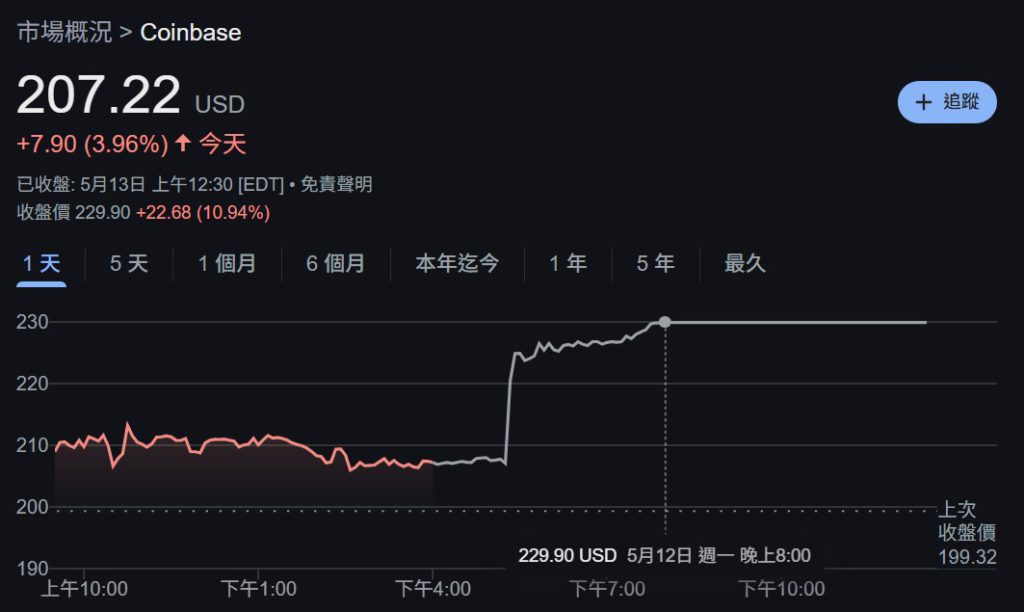Coinbase, the largest cryptocurrency exchange in the United States, is preparing to be included in the well-known S&P 500 index, making it the first "pure" cryptocurrency company to achieve this important milestone. This not only injects strength into the rapidly developing cryptocurrency industry but also has sparked widespread attention and discussion on Wall Street.
Coinbase Joins S&P 500 Index: Market Focus
According to the announcement released on May 12, 2025, at 6:05 PM Eastern Daylight Time, Coinbase (stock code: COIN) will officially be included in the S&P 500 index, expected to take effect before the market opens on May 19, 2025. Coinbase's inclusion marks the first company with a core cryptocurrency business to enter this large-cap stock benchmark index, which is widely considered the best single indicator of overall U.S. stock market performance. Any changes in the S&P 500 index components have always been a market focus.
Market Reaction: Stock Price Surge and Historical Review
After the news broke, Coinbase (COIN) stock jumped 8% after hours, trading at around $226. Although this price has fallen from the historical high of over $343 in early December of the same year, the market's enthusiastic response was evident.
Looking back, Coinbase was listed on Nasdaq on April 14, 2021, with the stock symbol COIN through a direct listing. Initially, its market value once reached about $85 billion, and currently stands at around $53 billion, maintaining its position as the largest publicly traded pure cryptocurrency company.
In fact, Oppenheimer analyst Owen Lau had predicted as early as February this year that, given Coinbase's growth for five consecutive months, the company might soon be included in the S&P 500 index, maintaining its "buy" rating and raising the target price to $388.

S&P 500 Selection Criteria: Financial and Regulatory Advantages
To be successfully included in the S&P 500 index, a company must meet a series of strict standards, including a market capitalization of at least $20.5 billion and profitability in the most recent quarter and the sum of the past four consecutive quarters. Additionally, the company's stock must be listed on major U.S. securities exchanges (such as NYSE or NASDAQ) and meet specific liquidity and issued share circulation standards, with most revenue typically coming from within the United States.
Given the inherent high volatility of the cryptocurrency market, Coinbase's profitability has been unstable in the past. For example, the company reported a strong revenue of $7.4 billion in 2021 but was once at a loss of $1.1 billion in the second quarter of 2022. However, the key turning point was Coinbase's reported adjusted net profit of $527 million in the first quarter of 2025, with quarterly total revenue reaching $2 billion (although down from $2.3 billion in the fourth quarter of 2024, with first-quarter trading revenue declining 19% to $1.2 billion and trading volume simultaneously dropping 10%).
It is this steady profitability that has met the key financial requirements for inclusion in the S&P 500 index. Market analysis generally believes that the relatively relaxed regulatory stance of the current Trump administration has brought a positive development environment for Coinbase and other cryptocurrency companies. In this atmosphere, other competing exchanges, including Bullish, Gemini, and Kraken, have also hinted at considering going public due to favorable regulatory conditions. Moreover, Coinbase has recently been actively expanding its business, such as agreeing to acquire the cryptocurrency derivatives exchange Deribit for $2.9 billion earlier this month. This move aims to expand its developing derivatives sector, given that derivatives trading accounts for a larger share of global cryptocurrency trading volume compared to Coinbase's dominant spot market in the United States.
Milestone Significance: Cryptocurrency Gains Acceptance in Traditional Financial System
Coinbase's successful inclusion in the S&P 500 index goes far beyond the company's own achievement, symbolizing a significant increase in cryptocurrency's acceptance in the traditional financial realm. Since many index-tracking funds, such as exchange-traded funds (ETFs) and mutual funds, allocate assets based on S&P 500 components, they will need to purchase Coinbase stocks in the future.
This move is expected to bring considerable institutional investment capital inflows to Coinbase. It is worth noting that the S&P 500 index already includes some companies providing cryptocurrency-related services, such as Block (formerly Square), PayPal, and Visa. However, Coinbase's inclusion as the first "pure" cryptocurrency trading company is particularly significant and prominent. In comparison, another well-known company, MicroStrategy (stock ticker MSTR), despite holding billions of dollars in Bitcoin, was not included due to factors such as smaller market capitalization. Therefore, Coinbase's addition undoubtedly sets a new and important precedent for other digital asset companies.
In the long term, this represents further market recognition and validation of cryptocurrencies, potentially accelerating mainstream institutional adoption of crypto assets and paving the way for other qualifying cryptocurrency companies to enter mainstream capital markets, thereby potentially changing the entire industry's competitive landscape. Simultaneously, this development may have potential positive impacts on future cryptocurrency regulatory frameworks, possibly encouraging regulators to view this emerging and vibrant industry with a more open and constructive attitude.







